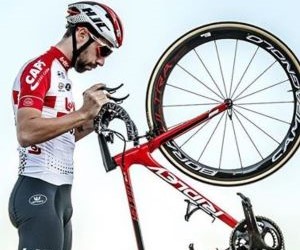Discover the most important cycling safety accessories every rider should have, from helmets to visibility gear, for safer and more confident rides.
WHAT STRETCHES SHOULD CYCLISTS DO BEFORE AND AFTER RIDES?
Cycling places unique demands on the body, requiring strong repetitive motions that can create tightness in the hips, quads, and hamstrings. Without stretching, cyclists risk injury, reduced power output, and slower recovery. Pre-ride stretches prime muscles for performance, while post-ride stretches restore flexibility and relieve tension. This guide details the most effective stretches cyclists should do before and after rides, explaining why they matter and how to perform them correctly. Incorporating these movements ensures better performance, fewer injuries, and a smoother ride experience.

Dynamic stretches before rides
Dynamic stretching involves active movements that increase blood flow and mobility. Unlike static stretches, which are held in place, dynamic exercises prepare muscles for the repetitive pedaling motion by warming up joints and activating neural pathways. These are ideal for pre-ride routines.
Leg swings
Stand beside a wall or bike for support. Swing one leg forward and backward in a controlled motion for 10–15 repetitions. Repeat on the other leg. This activates hip flexors, hamstrings, and glutes.
Walking lunges with twist
Step forward into a lunge, then twist your torso toward the leading leg. Alternate legs for 10–12 repetitions. This warms up quads, hip flexors, and core while promoting spinal mobility.
High knees
Jog in place while lifting knees toward your chest in a marching rhythm. Continue for 30 seconds. This elevates heart rate, increases circulation, and activates lower-body muscles for pedaling.
Why dynamic stretches matter
Increase blood flow to working muscles.
Activate key cycling muscle groups before exertion.
Reduce risk of strains during the ride.
Mentally prime the rider for performance.
By starting with dynamic stretches, cyclists ensure muscles are warm, responsive, and ready for sustained effort on the bike.
Static stretches after rides
Post-ride stretching should focus on static holds that restore length to muscles shortened by cycling. These stretches relieve tension, improve flexibility, and aid in recovery by enhancing circulation and reducing soreness.
Hamstring stretch
Sit on the ground with one leg extended and the other bent. Reach toward the toes of the extended leg while keeping your back straight. Hold for 20–30 seconds per side. This stretch counters hamstring tightness caused by constant flexion during pedaling.
Quadriceps stretch
Stand on one leg and pull the opposite foot toward your glutes, keeping knees close together. Hold for 20–30 seconds. This restores flexibility to quads heavily engaged during climbs and sprints.
Hip flexor stretch
Kneel on one leg in a lunge position, pushing hips forward while keeping chest upright. Hold for 20–30 seconds per side. This relieves tightness from prolonged forward-leaning posture on the bike.
Calf stretch
Stand facing a wall, placing one foot forward and the other back. Keep the rear heel pressed to the floor while leaning forward. Hold for 20–30 seconds per side. This stretch helps prevent Achilles tendon strain and calf cramps.
Why static stretches matter
Relieve muscle tightness after long rides.
Support faster recovery and reduce soreness.
Promote flexibility for smoother pedal strokes.
Help maintain long-term joint health.
Static stretches after rides ensure cyclists recover faster and maintain mobility for consistent training.
Core and back stretches for balance
Cycling posture places stress on the lower back and core. Neglecting these areas can lead to chronic stiffness, pain, or even long-term injuries. Stretching the spine and abdominal muscles improves balance, posture, and comfort on and off the bike.
Cat-cow stretch
On hands and knees, alternate between arching your back upward (cat) and dipping your spine downward (cow). Repeat for 8–10 cycles. This stretch mobilizes the spine and relieves back tension.
Child’s pose
Kneel on the floor, sit back on your heels, and extend arms forward on the ground. Hold for 30 seconds. This elongates the spine and opens hips, reducing pressure from extended riding posture.
Torso twist stretch
Sit cross-legged on the floor. Place your right hand on your left knee and twist gently to the side. Hold for 20 seconds per side. This increases spinal mobility and core flexibility.
Why stretching core and back matters
Relieves stiffness from hunched cycling posture.
Prevents lower back pain during long rides.
Improves posture and overall riding comfort.
Supports balance and stability on the bike.
Core and back stretches complete the pre- and post-ride routine, ensuring cyclists remain balanced, strong, and pain-free through consistent training.
YOU MAY ALSO BE INTERESTED






